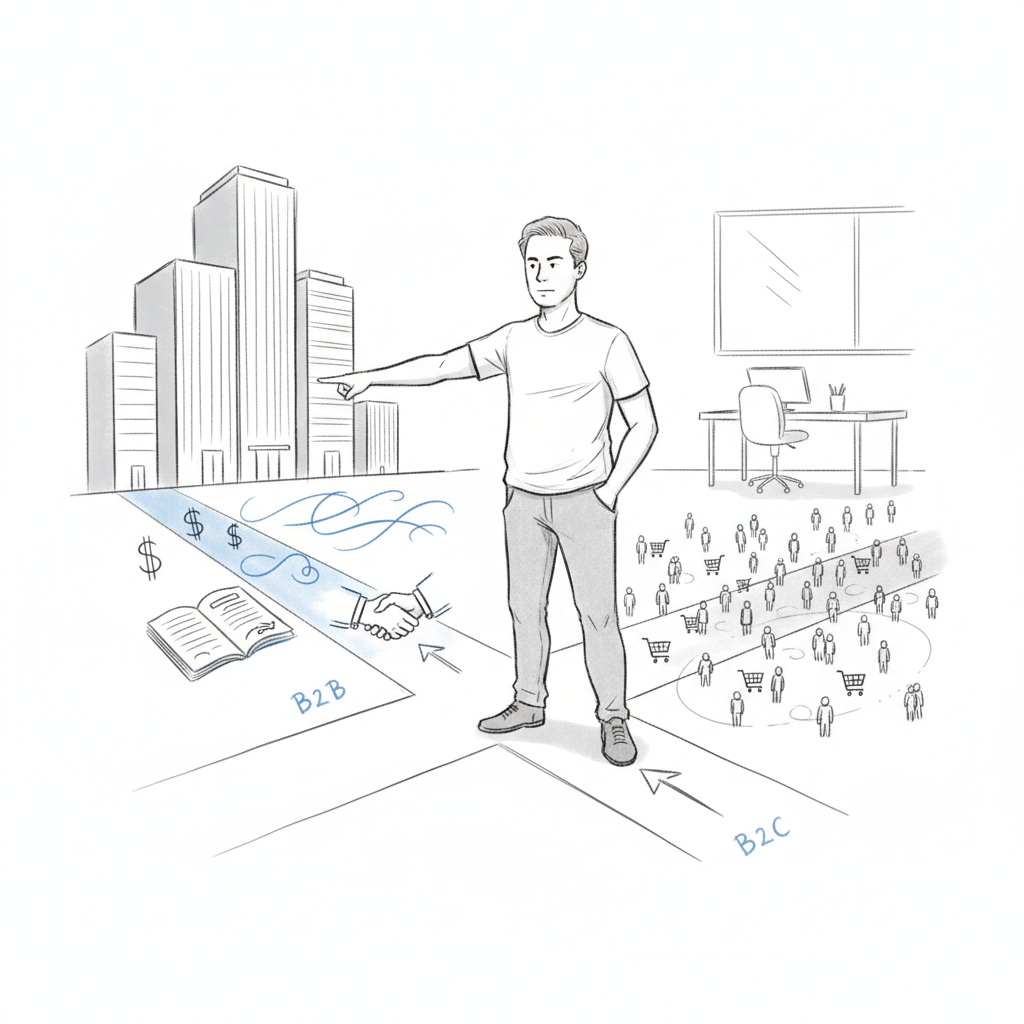
Why I Chose B2B Over B2C as a Solo Founder (And Never Looked Back)
Why B2C Is a Death Trap for Solo Founders
I want to make this very clear from the start: if you’re a solo founder trying to build a B2C business without VC funding, you’re basically entering a car race on a bycicle while everyone else enroll with Ferraris. And look, I’ve been down this road, watched countless others crash and burn, and the math just doesn’t math in your favor.
When I first started building products, I fell for the same trap everyone does. Back then (2010) consumer apps were all the rage. You see these viral consumer apps blowing up on App Store like a dieting app or productivity tool that seemingly came out of nowhere - and you think, “That could be me.”
Well, here’s the reality check: that’s an outlier. You’re not going to have that every day for every person, for most products. That’s just not going to happen.
The Brutal Math of Consumer Products
Let me break down the numbers. Say you’re selling something for $20 per month - pretty standard B2C pricing. To hit even a modest $2,000 in monthly recurring revenue, you need 100 paying customers.
Sounds doable, right? lol. NO!
You’re not pro at marketing, trust me, most of us aren’t. An amateur marketers typically see sub-1% conversion rates. (i.e. 100 people see your landing page, 7/8th of the person buys)
Even if you optimize everything perfectly, you might push that to 1.5% from all the eyeballs you attract.
So to get those 100 customers, you need to reach thousands - potentially tens of thousands - of prospects. And reaching that many people?
That takes serious resources. You can tweet at your 400 followers all day long, it won’t cut it, and you can only do so many dances on TikTok.
But…what about SEO?
It’s legit. Until it is not. I’ve watched founders pour months into SEO, thinking organic traffic will save them. And yeah, once you perfect it after months and months of work, you can get quite a bit of traffic on your website.
Then Google updates their algorithm and if you’ve been doing some shady stuff - you’re f*cked.
But the bottleneck is still volume. You need massive numbers to justify those fairly cheap prices under $100, and as a solo founder, you simply don’t have the bandwidth to play that game.
Why Businesses Pay More and Complain Less
Now let’s talk about the B2B side, where the economics actually make sense for solo founders. When you’re selling to businesses, you can charge $200, $300, even $500 per month without batting an eye. Suddenly, you need way fewer clients to hit your revenue targets.
The ting is, businesses operate on logic, not emotion. A consumer will think twice before paying for a $20 product every month. That $20 subscription is going to be a consideration for a lot of people. They’ll weigh it emotionally, wonder if they really need it, compare it to their Netflix subscription or how many soy lattes they will have to skip. (Spoiler: they are not going to sacrafice it for your productivity app).
Businesses?
Totally different story. A $500 subscription for a business is a no-brainer if the accounting makes sense. If it helps their business grow and there’s a positive ROI it’s an automatic yes (the only question is if it’s your product or competitor’s.) They don’t need to think and emotionally consider it the way consumers do.
The Two Magic Words: Overhead and Revenue
When I’m evaluating B2B opportunities, I look for two things: can this reduce overhead or increase revenue? That’s it. Everything else is noise.
I want to make a sidenote: there is an advanced level to this game called: Loss Prevention.
It’s a whole different ball game and I’m not going to cover it here. But, if you sell audits, pentests, cybesec, legal, compliance or liability reduction services - you can print money in the Large Biz and Enterprise space. I call it “Save Their Ass” business model. More on that in another article.
Backe to our topic.
On the overhead reduction: we’re talking about business productivity tools, project management software, anything that optimizes workflow, eliminates manual work or reduces headcount. If a business can avoid hiring an employee or get existing employees to work twice a effeciently, they’ll happily pay a fraction of those savings to keep the benefit going.
The revenue side is even more compelling. If business cannot reduce overhead, they try to increase revenue. (Duh!) So, this is marketing automation that helps them set up campaigns quickly, finetune ad targeting, lead generation tools, advertising optimization… these directly impact the bottom line.
Here’s a example: if a business currently pays $100 per lead acquired (from ads) and your ad performance analytics solution brings that cost down to $50, they just took 50% discount on ad spend. And trust me, most SMBs don’t know how to run ads, neither they have a clue what a good ad looks like. So business owners will gladly pay a few hundred bucks (per motnth!) to maintain that advantage. This understanding of business relationships is crucial for building what I call the Circle of Trust with your customers.
The Consumer Tier Trap
I spent nearly two decades working with SaaS businesses and if I had a penny everytime this happens.
I’ve seen this pattern play out too many times to count.
A founder builds successful B2B software, starts making good money, then decides to add a consumer tier. Usually driven by “small fish” customers that complain that their products are too expensive.
They see Adobe going from $600 for Photoshop to $20 per month for a subscription. They see Microsoft going from $300 for Office to $6 per month for Office 365. They think, “hmm if big dawgs are doing it, I should do it too.”
OR maybe they want to capture freelancers or small business owners (just like them).
Seems logical, right? More customers, more revenue.
Wrong. Often, “more customers = more headaches”
What happens is those small customers just tank their support. CS would get flooded with emails, service requests, complaints, poor ratings and all kinds of nasty Karens calling up.
Yeah yeah, I know, freelancers might call themselves businesses, but they operate like consumers - and this is a VERY difficult market to satisify, as many go from feast to famine with their cashflow.
If you want to see buttload of “Card Declined: Insufficient Funds” - go for Freelancers as customers. It’ll be fun.
As a solo founder, your bandwidth is everything. Every hour you spend dealing with price-sensitive consumers is an hour not spent building features for high-value business customers who actually move the needle on your revenue.
The B2B Path Forward
I don’t understand why so much of the indie developer community is adamant about serving individual users. Yeah, there’s a market for consumer products, but it’s usually not for solo founders. It’s not for a single person trying to break into a market without massive funding behind them (or existing cashflow business to support marketing costs). This is also why understanding the untapped power of the founder’s brand is so important in B2B - businesses buy from people they trust.
The economics are simple: businesses pay more, complain less, and make purchasing decisions based on ROI rather than emotion. When you’re juggling everything yourself, you need customers who understand the value of what you’re building and have budgets allocated for it.
Look, I’m not saying B2B is easy. You still need to build something valuable, market it effectively, and deliver results. But at least with B2B, the math is on your side. You can build a sustainable business with dozens of customers instead of needing thousands. And frankly, when you’re doing everything yourself, that’s the only path that makes sense.
So if you’re sitting there planning your next consumer app, thinking you’ll be the exception, I want you to seriously reconsider. The graveyard of failed B2C startups is littered with talented solo founders who thought they could beat the odds. Meanwhile, boring B2B software is quietly making millionaires out of developers who understood where the real opportunity lies. In fact, the truth about AI wrappers shows that even with AI democratizing development, B2B fundamentals still apply.
Trust me on this one. Go where the money actually is.
